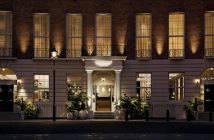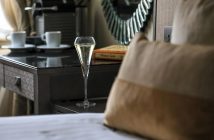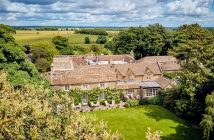This weekend we venture to the ‘Athens of Africa’, the mystical, alluring city of Fes, home of brightly-coloured buildings, a music festival with a difference and the eponymous hat. In this first part, Lydia discovers a delectable hideaway…
It was a gloomy day in London, heavy sky and biting winds, when I was asked how the idea of a trip to Fes grabbed me…
It grabbed me hard.
Harder still once I’d read up on Morocco’s second largest city: Fes boasts the hot-but-not-punishing springs of the Middle Atlas region (highs of 30°C in April), a UNESCO World Heritage site (the Fes el Bali medina), and reportedly fantastic food – I had it on friends’ authority the Fassi way with a tagine alone is worth the three hour journey from London. Not to mention some of the most beautiful riads and gardens in the country – among them the recently-restored Art Deco splendours of Palais Amani, a 17th century riad inside the walled city-within-a-city of the Fes medina.
And it grabbed me hardest of all once I learned about Palais Amani’s habit of leaving welcome gifts of Moroccan slippers in their rooms. Like they say, you should never turn down a chance to see the man in your life in sultan-esque, pointy-toed leather slippers.
I’m pretty sure they say that.
So that’s what brings us here, to the winding, narrow streets of Fes el Bali. We’re being led through its labyrinthine alleys by Houssam Laassiri, head chef at the Palais Amani and our tutor for the morning on their half-day cookery course. Both of us are focused very intently on Laassiri, in part because the medina demands it. To look away for more than a few seconds would be to lose him in the press of the crowd, or around a sudden corner in the maze of over 9500 streets – mostly unmarked – that makes up the Fes el Bali medina.
The other incentive for not looking away is Laassiri’s expertise, and the nuggets of wisdom he’s sharing as he prods aubergines and squeezes citrus along the way. He’s keen to impress upon us Fes’s agricultural prowess. And it is duly impressive. The land surrounding the city is responsible for almost everything we see in the medina’s food markets – from the sheafs of mint, the long strings of dried figs and the jars of preserved lemons to the buckets of olives smeared with harissa paste and the thick, white wheels of goats cheese wrapped in palm leaves. Ditto the occasional disembodied sheep’s head hanging above butchers’ stalls, a phalanx of stray cats waiting hopefully underneath.
Clearly – and it’s not greed, or not just greed, that prompts me to tell you this – the best way to get under the skin of Fes is to eat. To eat a lot. How could you get a better insight into the city’s centuries-old melding of Indian, Persian and Andalusian influences? It’s a fusion born from the ancient trade routes running through this area, the intersection of cultures at the caravanserai wayposts making Fassi food distinct among that of its North African neighbours.
A perfect example is the pastilla, a crunchy, cinnamon-dusted meat pastry. Traditionally made with pigeon, now often made with chicken; if you can imagine a large, sugary chicken-cake, and then imagine it being equally amazing and confusing you’re on the right track. The carts selling snail soup attract equally large queues in the medina, but we forsake it in favour of freshly-baked breads – the dough rolled out into paper-thin sheets and draped over hot plates; from raw to breakfast in 60 seconds flat – wrapped in paper and eaten standing among those cheeses, mint-sheafs and sheep’s heads.
As a tourist, the food of Fes feels polarised between the vastly luxurious offerings at the riads and hotels of the medina, and this huge array of ready-in-seconds streetfoods. We dip between both: paprika-dusted breads; Sephardic bitter orange and almond cake; slabs of sesame, peanut and honey from holes-in-the-wall in the medina. Five-course Moroccan breakfasts and tapas-style dinners in the mosaic-tiled, lantern-lit opulence of the courtyard garden at the Palais Amani; ornate cocktails at sunset on their roof terrace, overlooking the medina on one side and the tombs and hilltop ruins outside the city in the other direction.
Spectacular food aside, you can see why Fes, and Palais Amani in particular, are popular with honeymooners. It’s a powerful and compelling contrast between the crumbling grandeur of the medina – indecipherable streets, towering minarets and the enormous, leather-working vats at the Tannery Chouara, with the tiny figures of the tanners moving inside them – and the sheer luxury that the huge wooden doors open onto at the Palais Amani. That roof terrace, beautiful though it is, is subjected to some serious one-upmanship from the bedrooms, no less mosaic-floored and lantern-filled than the gardens – perfect for honeymooners and anybody wanting seclusion. Though arguably nothing we do in that bedroom is that much more intimate than the Palais Amani hammam, a secret, rose-petal covered room underneath the gardens where I’m rubbed with black salts, sluiced with rosewater, warmed on marble counters and finally, showered so very tenderly by my masseuse that I can only assume she is in love with me.
Who could blame her if she is? The Palais Amani practically demands romance to bloom, among the fountains and the citrus-trees and the beautiful, secluded rooms and the cold Casablanca beers on the roof in the warm evenings. And of course the food. By the time Ric and I finish eating the product of our cookery class – the zaalouk salad of charred aubergine, and the tagine studded with chicken-heart and preserved lemon – I suspect either of us would run away with Laassiri if he asked us to.
He doesn’t ask us to. But we’ll always have Palais Amani.
Our Fes portrait continues tomorrow when Karen Yates finds her inner hippy at the Sacred Music Festival (geddit?)…
Palais Amani is at 12 Derb el Miter, Medina, Fes, Morocco. A three-night stay for two including breakfasts, two dinners, cooking class and tour of the Medina starts at €750.
The hammam, restaurant and cookery courses are open to non-residents: a traditional hammam experience starts at €48 and a half-day Moroccan Riad Cookery course starts at €95 per person.
To view rooms and for bookings visit www.palaisamani.com
Photos by the author.




